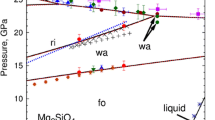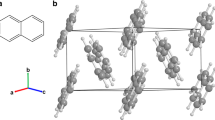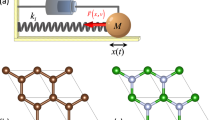Abstract
We use Kieffer’s model to represent the vibrational density of states (VDoS) and thermodynamic properties of pure substances in pressure–temperature space. We show that this model can be simplified to a vibrational model in which the VDoS is represented by multiple Einstein frequencies without significant loss of accuracy in thermodynamic properties relative to experimental data. The resulting analytical expressions for thermodynamic properties, including the Gibbs energy, are mathematically simple and easily accommodated in existing computational software for making thermodynamic databases. We show for aluminium, platinum, orthoenstatite and forsterite that thermodynamic properties can be represented with comparable accuracy as with Kieffer’s model with the same number of fitting parameters as in the Mie–Grüneisen–Debye model. We demonstrate that the method enables to achieve thermodynamic properties with superior accuracy relative to the Mie–Grüneisen–Debye method. The method is versatile in the sense that it allows incorporating dispersion of Grüneisen parameters. It is possible to extend the formalism to include other physical effects, such as intrinsic anharmonicity in the same way as in vibrational models based on Kieffer’s formalism.










Similar content being viewed by others
References
Al’tshuler LV, Brusnikin SE, Kuz’menkov EA (1987) Isotherms and Grüneisen functions for 25 metals. J Appl Mech Tech Phys 28:129–141
Anderson OL (1996) Anharmonicity of forsterite and the thermal pressure of insulators. Geophys Res Lett 23:3031–3034
Ashida T, Kume S, Ito E (1987) Thermodynamic aspects of phase boundary among α-, β-, and γ-Mg2SiO4. In: Manghnani MH, Syono Y (eds) High pressure research in mineral physics. Terra Scientific Publishing Company (TERRAPUB), Tokyo/American Geophysical Union, Washington, pp 269–274
Ashida T, Kume S, Ito E, Navrotsky A (1988) MgSiO3 ilmenite: heat capacity, thermal expansivity and enthalpy of transformation. Phys Chem Miner 16:239–245
Austin JB (1932) A vacuum apparatus for measuring thermal expansion at elevated temperatures with measurements on platinum, gold, magnesium, and zinc. Physics 3:240–267
Barin I (1989) Thermochemical data for pure substances, Part II. VCH Verlags-gesellschaft mbH, D6940 Weinheim, Germany
Berg WT (1969) The low temperature heat capacity of platinum. J Phys Chem Solids 30:69–72
Bouhifd MA, Andrault D, Fiquet G, Richet P (1996) Thermal expansion of forsterite up to the melting point. Geophys Res Lett 23:1143–1146
Chopelas A (1990) Thermal properties of forsterite at mantle pressures derived from vibrational spectroscopy. Phys Chem Miner 17:149–156
Chopelas A (1999) Estimates of mantle relevant Clapeyron slopes in the MgSiO3 system from high-pressure spectroscopic data. Am Miner 84:233–244
Choudury N, Chaplot SL (2000) Free energy and relative stability of the enstatite Mg2Si2O6 polymorphs. Solid State Commun 114:127–132
Clusius K, Losa CG, Fransozini P (1957) Ergebinisse der Tieftemperaturforschung. Die Bildfehler de XVIII. Die Atom- und Elektronenwärme des Platins zwischen 0°K und 273°K. Z Naturforsch 12A:34–38
Collard SM, McLellan RB (1992) High-temperature elastic constants of platinum single crystals. Acta Metall Mater 40:699–702
Cynn H, Carnes JD, Anderson OL (1996) Thermal properties of forsterite, including C V , calculated from αK T through the entropy. J Phys Chem Solids 57:1593–1599
Dewaele A, Loubeyre P, Mezouar M (2004) Equations of state of six metals above 94 GPa. Phys Rev B 70:094112/1-8
Dorogokupets PI, Oganov AR (2007) Ruby, metals, and MgO as alternative pressure scales: a semiempirical description of shock-wave, ultrasonic, X-ray, and thermochemical data at high temperatures and pressures. Phys Rev B 75:024115/1-16
Dutton DH, Brockhouse BN, Miller AP (1972) Crystal dynamics of platinum by inelastic neutron scattering. Can J Phys 50:2915–2927
Eriksson O, Wills JM, Wallace D (1992) Electronic, quasiharmonic, and anharmonic entropies of transition metals. Phys Rev B 64:5221–5227
Fabrichnaya O, Saxena SK, Richet P, Westrum EF Jr (2004) Thermodynamic data, models, and phase diagrams in multicomponent oxide systems, Springer, New York
Fradin FY, Koelling DD, Freeman AJ, Watson-Yang TJ (1975) Calculation of the electronic structure and related physical properties of platinum. Phys Rev B 12:5570–5574
Gasparik T (2003) Phase diagrams for geoscientist. Springer, New York
Gillet P, Richet P, Guyot F, Fiquet G (1991) High-temperature thermodynamic properties of forsterite. J Geophys Res 96:11805–11816
Gilvarry JJ (1955) Grüneisen’s law and the fusion curve at high pressure. Phys Rev 102:317–325
Grimvall G (1968) Temperature dependent effective masses of conduction electrons. J Phys Chem Solis 29:1221–1225
Hahn TA, Kirby RK (1972) Thermal expansion of platinum from 293 to 1900 °K. AIP Conf Proc 3:87–95
Holland TJB, Powell R (1998) An internally consistent thermodynamic data ser for phases of petrological interest. J Metamorph Geol 16:309–343
Holmes NC, Moriarty GR, Gathers GR, Nellis WJ (1989) The equation of state of platinum to 660 GPa (6.6 Mbar). J Appl Phys 66:2962–2967
Hugh-Jones D (1997) Thermal expansion of MgSiO3 and FeSiO3 ortho- and clino pyroxenes. Am Miner 82:689–696
Isaak DG, Anderson OL, Goto T (1989) Elasticity of single-crystal forsterite measured to 1700 K. J Geophys Res 94:5895–5906
Jackson JM, Palko JW, Andrault D, Sinogeikin SV, Lakshtanov DL, Wang J, Bass JD, Zha C-S (2003) Thermal expansion of natural ortho enstatite to 1473 K. Eur J Miner 15:469–473
Jacobs MHG, de Jong BHWS (2005) Quantum-thermodynamic treatment of intrinsic anharmonicity; Wallace’s theorem revisited. Phys Chem Miner 32:614–626
Jacobs MHG, de Jong BHWS (2007) Placing constraints on phase equilibria and thermophysical properties in the system MgO-SiO2 by a thermodynamically consistent vibrational method. Geochim Cosmochim Acta 71:3630–3655
Jacobs MHG, de Jong BHWS (2009) Thermodynamic mixing properties of olivine derived from lattice vibrations. Phys Chem Miner 36:365–389
Jacobs MHG, Oonk HAJ (2012) Equilibrium between phases of matter. Supplemental text for material science and high-pressure geophysics. Springer, Dordrecht
Jacobs MHG, Schmid-Fetzer R (2010) Thermodynamic properties and equation of state of fcc aluminum and bcc iron, derived from a lattice vibrational method. Phys Chem Miner 37:721–739
Jacobs MHG, van den Berg AP (2011) Complex phase distribution and seismic velocity structure on the transition zone: convection model predictions for a magnesium-end member olivine-pyroxene mantle. Phys Earth Planet Int 186:36–48
Jacobs MHG, van de Berg AP, de Jong BHWS (2006) The derivation of thermo-physical properties and phase equilibria of silicate materials from lattice vibrations: application to convection in the Earth’s mantle. Calphad 30:131–146
Jaeger FM, Rosenbohm E (1939) The exact formulae for the true and mean specific heats of platinum between 0° and 1600°C. Physica 6:1123–1125
Kajiyoshi K (1986) High-temperature equation of state for mantle minerals and their anharmonic properties, MS Thesis. Okayama University, Okayama
Kanzaki M (1991) Ortho/Clino enstatite transition. Phys Chem Miner 17:726–730
Kelley KK (1943) Specific heats at low temperatures of magnesium orthosilicate and magnesium metasilicate. J Am Chem Soc 65:339–341
Kendall WB, Orr RL, Hultgren R (1962) Heat content of platinum. J Chem Eng Data 7:516–518
Kieffer SW (1979) Thermodynamics and lattice vibrations of minerals: 3 lattice dynamics and an approximation for minerals with application to simple substances and framework silicates. Rev Geophys Space Phys 17:35–59
Knapp GS, Jones RW (1972) Determination of the electron-phonon enhancement factor from specific-heat data. Phys Rev B 6:1761–1767
Kresch M, Lucas M, Delaire O, Lin JYY, Fultz B (2008) Phonons in aluminum at high temperature studied by inelastic neutron scattering. Phys Rev B 77:024301/1-9
Krupka KM, Richard A, Hemingway BS, Ito J (1985a) Low-temperature heat capacities and derived thermodynamic properties of anthophyllite, diopside, enstatite, bronzite, and wollastonite. Am Miner 70:249–260
Krupka KM, Hemingway BS, Robie RA, Kerrick DM (1985b) High-temperature heat capacities and derived thermodynamic properties of anthophyllite, diopside, dolomite, enstatite, bronzite, talc, tremolite, and wolastonite. Am Miner 70:261–271
Li L, Wentzcovitch RM, Weidner DJ, Da Silva CRS (2009) Vibrational and thermodynamic properties of forsterite at mantle conditions. J Geophys Res 112:B05206/1-8
Lukas HL, Fries SG, Sundman B (2007) Computational thermodynamics, the Calphad method. Cambridge University Press, Cambridge
Manghnani MH, Matsui T (1981) Temperature dependence of pressure derivatives of single-crystal elastic constants of pure forsterite. ISPEI Symposium on properties of materials at high pressures and temperatures. Toronto, Canada
Marsh SP (1980) LASL shock hugoniot data. University of California Press, Berkeley
Matsui T, Manghnani MH (1985) Thermal expansion of single-crystal forsterite to 1023 K by Fizeau interferometry. Phys Chem Miner 12:201–210
Mohr PJ, Taylor BN, Newell DB (2012) CODATA recommended values of the fundamental physical constants: 2010. Rev Mod Phys 84:1527–1605
Oganov AR, Dorogokupets P (2004) Intrinsic anharmonicity in equations of state and thermodynamics of solids. J Phys Condens Matter 16:1351–1360
Piazzoni AS, Steinle-Neumann G, Bung H-P, Dolejš D (2007) A mineralogical model for density and elasticity of the Earth’s mantle. Geochem Geophys Geosyst 8:1–23
Price GD, Parker SC, Leslie M (1987) The lattice dynamics and thermodynamics of the Mg2SiO4 polymorphs. Phys Chem Miner 15:181–190
Robie RA, Hemingway BS (1995) Thermodynamic properties of minerals and related substances a 298.15 K and 1 bar (105 Pascals) pressure and at higher temperatures. United States Geological Survey Bulletin No. 2131
Robie RA, Hemingway BS, Takei H (1982) Heat capacities and entropies of Mg2SiO4, Mn2SiO4 and Co2SiO4 between 5 and 380 K. Am Miner 67:470–482
Stixrude L, Lithgow-Bertelloni C (2005) Thermodynamics of mantle minerals—I. Physical properties. Geophys J Int 162:610–632
Sumino Y, Nishizawa O, Goto T, Ohno I, Ozima M (1977) Temperature variation of elastic constants of single-crystal forsterite between −190 and 400°C. J Phys Earth 23:377–392
Suzuki I (1975) Thermal expansion of periclase and olivine, and their anharmonic properties. J Phys Earth 23:145–159
Suzuki I, Anderson OL, Sumino Y (1983) Elastic properties of a single-crystal forsterite Mg2SiO4 up to 1200 K. Phys Chem Miner 10:38–46
Suzuki I, Takei H, Anderson OL (1984) Thermal expansion of single-crystal forsterite Mg2SiO4. In: The proceedings of the eight international thermal expansion symposium, sponsored by the national bureau of standards. Plenum Pub Co, New York, pp 79–88
Thiéblot L, Téqui C, Richet P (1999) High-temperature hat capacity of grossular (Ca3Al2Si3O12), enstatite (MgSiO3) and titanite (CaTiSiO5). Am Miner 84:848–855
Tsuchiya T, Kawamura K (2002) First-principles electronic thermal pressure of metal Au and Pt. Phys Rev B 66:094115/1-5
Vinet P, Ferrante J, Rose JH, Smith JR (1987) Compressibility of solids. J Geophys Res 92:9319–9325
Vinet P, Ferrante J, Rose JH, Smith JR (1989) Universal features of the equation of state of solids. J Phys Condens Matter 1:1941–1963
Wallace DC (1972) Thermodynamics of crystals. Wiley, New York
Watanabe H (1982) Thermochemical properties of synthetic high-pressure compounds relevant to the Earth’s mantle. In: Manghnani MH, Akimoto S (eds) High-pressure research in geophysics. Center for Academic Publications, Japan/Tokyo: Reidel/Dordrecht, pp 441–464
White GK (1972) Thermal expansion of platinum at low temperatures. J Phys 2F(2):L30–L31
Xu W, Lithgow-Bertelloni C, Stixrude L, Ritsema J (2008) The effect of bulk composition and temperature on mantle seismic structure. Earth Planet Sci Lett 275:70–79
Yang H, Ghose S (1995) High-temperature single crystal X-ray diffraction studies of the ortho-proto phase transition in enstatite, Mg2Si2O6 at 1360 K. Phys Chem Miner 22:300–310
Yokokawa H, Takahashi Y (1979a) Analysis of heat capacity of platinum: electron-phonon effects and anharmonic contribution. J Phys Chem Solids 40:445–448
Yokokawa H, Takahashi Y (1979b) Laser-flash calorimetry II. Heat capacity of platinum from 80 to 1000 K and its revised thermodynamic functions. J Chem Thermodyn 11:411–420
Yusa H, Akaogi M, Ito E (1993) Calorimetric study of MgSiO3 garnet and pyroxene: heat capacities, transition enthalpies, and equilibrium phase relations in MgSiO3 at high pressures and temperatures. J Geophys Res 98:6453–6460
Acknowledgments
MHG Jacobs gratefully acknowledges financial support by the German Research Foundation (DFG) under Grant no. JA 1985/1. Collaboration between A. van den Berg and M. Jacobs has been supported through The Netherlands Research Center for Integrated Solid Earth Science (ISES) project ME-2.7. We wish to express our gratitude to M. Ghiorso and an anonymous reviewer for constructive suggestions which improved the quality of the manuscript significantly.
Author information
Authors and Affiliations
Corresponding author
Appendix
Appendix
Thermodynamic expressions of properties in which the VDoS is represented by multiple Einstein oscillators are derived from the Helmholtz energy. Vinet et al.’s (1987, 1989) equation of state for the static lattice has been used. For aluminium, the electronic contribution to the Helmholtz energy is described with a free electron gas model containing the electronic Grüneisen parameter γ el and the electronic coefficient β el. \( V_{0}^{\text{st}} \), \( K_{0}^{\text{st}} \) and \( K_{0}^{{\prime {\text{st}}}} \) denote the volume, bulk modulus and its pressure derivative for the static lattice in which vibrational motions are absent. V 0 represents the volume of the vibrating lattice at zero Kelvin and zero pressure. U ref is a reference energy at zero Kelvin and zero pressure and adjusted in such a way that the enthalpy at 298.15 K and 1 bar pressure is represented. For forsterite and orthoenstatite, we used values given by Robie and Hemingway (1995), whereas for elemental aluminium and platinum heat of formations at ambient conditions are zero. The expressions below are for the quasi-harmonic case and therefore do not contain an intrinsic anharmonicity contribution.
In the equations below, we define the volume ratio, η as:
Helmholtz energy
Energy
Isochoric heat capacity
Entropy
Isothermal bulk modulus
Temperature derivative of pressure
Thermal expansivity
Thermal expansivity is calculated from the total bulk modulus, Eq. (18) and temperature derivative of pressure, Eq. (19).
Isobaric heat capacity
Isobaric heat capacity is calculated from isochoric heat capacity, Eq. (16), bulk modulus, Eq. (18), and thermal expansivity Eq. (20).
Total pressure
Gibbs energy
The Gibbs energy is calculated from the Helmholtz energy, Eq. (14) and pressure Eq. (22).
Enthalpy
The enthalpy is calculated from the energy, Eq. (15) and pressure, Eq. (22).
Equations (14)–(24) are used as follows. At a selected condition of pressure and temperature, and input parameters as given in, for example, Table 2, the volume is calculated from Eqs. (9), (10) and (22). The calculation of volume is achieved numerically in an iteration process. Once volume has been established, all thermodynamic properties are calculated analytically.
Contributions due to intrinsic anharmonicity
The expressions presented above can be extended to include intrinsic anharmonicity. The formalism presented by Jacobs and de Jong (2005) requires expressions in which the quasi-harmonic expressions above are quite complicated to use. Here, we present an alternative based on a thermodynamic perturbation formalism presented by Oganov and Dorogokupets (2004). In that case, the expressions below should be added to the corresponding expressions for thermodynamic properties. The anharmonicity parameter is given by:
The first and second volume derivatives at constant temperature, necessary in thermal pressure, its isochoric temperature derivative and bulk modulus are given as \( a_{j}^{\prime } \) and \( a_{j}^{\prime \prime } \). The volume dependence of the anharmonicity parameter was used for platinum, but not for aluminium, forsterite and orthoenstatite. Its usual expression is
In Eq. (26), a j,0 is the anharmonicity parameter at zero Kelvin, zero pressure and z a constant. To obtain shorter expressions below, we define
Note that the Einstein temperature in the thermodynamic formulation for the Helmholtz energy of Oganov and Dorogokupets (2004) and the expressions below is given by the quasi-harmonic expressions, Eqs. (9, 10) and that not the temperature and volume dependent property resulting from Eq. (25) should be used.
Anharmonic contribution to entropy
Anharmonic contribution to isochoric heat capacity
Anharmonic contribution to thermal pressure
Anharmonic contribution to isochoric temperature derivative of thermal pressure
Anharmonic contribution to isothermal bulk modulus
A computer program written in Fortran for the calculation of thermodynamic properties of pure substances in pressure–temperature space will be made available on request.
Rights and permissions
About this article
Cite this article
Jacobs, M.H.G., Schmid-Fetzer, R. & van den Berg, A.P. An alternative use of Kieffer’s lattice dynamics model using vibrational density of states for constructing thermodynamic databases. Phys Chem Minerals 40, 207–227 (2013). https://doi.org/10.1007/s00269-012-0562-4
Received:
Accepted:
Published:
Issue Date:
DOI: https://doi.org/10.1007/s00269-012-0562-4




